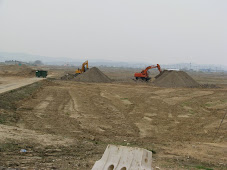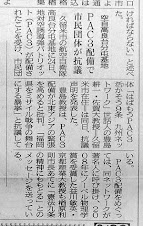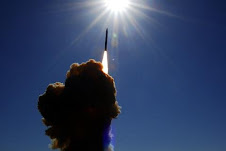
Yonhap News
SEOUL, June 27 (Yonhap) -- South Korea's first geostationary ocean-weather satellite has successfully reached Earth's orbit after being launched from Guiana Space Center in Kourou, French Guiana, the government said Sunday.
The Ministry of Education, Science and Technology said the Chollian communication, ocean and meteorological satellite (COMS) blasted off from French Guiana on an Ariane 5-ECA rocket at 6:41 a.m. (Korea Time) after encountering minor technical problems on Thursday and Friday that delayed the launch.
The Chollian successfully reached "geostationary transfer orbit" and separated from the second stage rocket roughly 32 minutes after takeoff at an altitude of little over 2,000 kilometers, the ministry in charge of the country's space program said.
It said the Dongara ground station in Australia established initial contact with the Chollian at 7:19 a.m., indicating that the satellite has reached a correct orbital path and its electrical, on-board equipment and flight position were all normal. Additional contacts are to be made with ground stations in Hawaii, Italy and Chile for around-the-clock communications uplink with COMS.
First communication with the state-run Korea Aerospace Research Institute (KARI) -- in charge of the satellite -- is expected to take place 10 days after liftoff.
About 30 technicians from South Korea and France will be on hand to check the overall condition of the satellite and communications status at all times in the initial weeks of operations.
A series of tests will be conducted on its onboard equipment in the coming months with communications, maritime observation and weather services to be offered from late December.
The ministry said if there are no unforeseen problems, the satellite should start to deploy its solar panels and use its small booster rockets to reach stable orbital altitude of 36,000 kilometers in the next eight days.
It will be in a fixed orbit circling the equator at east longitude 128.2 degrees that can give 24-hour coverage over the Korean Peninsula.
Kim Young-shik, deputy minister of science and technology, said the successful launch of the Chollian marks a milestone in South Korea's space technology development and will positively affect everyday life.
The satellite was built in cooperation with France's EADS Astrium with South Korean engineers from the Electronics and Telecommunications Research Institute (ETRI) and the Korea Ocean Research and Development Institute playing a key role in its development, design and production. ETRI built the communications equipment for the satellite.
"The satellite is special because it can offer communication services as well as timely weather and oceanographic information that can benefit peoples' lives," the official said after the launch.
The 2,460-kilogram satellite is the world's first geostationary ocean monitoring satellite that is designed to give the country timely and accurate data in such areas as the movement of tide, ocean temperatures and environmental changes that can be used to better control maritime resources.
The Chollian also makes South Korea the seventh country after the United States, the European Union, Japan, China, India and Russia to operate an independent weather satellite and the 10th to build its own communications satellite.
The science ministry and KARI said the new satellite is designed to send weather and oceanographic data every 15 minutes and can reduce the interval to every 8 minutes in emergency situations such as when a typhoon is approaching the country. At present, Seoul gets its weather information from foreign satellites operated by Japan every 30 minutes, and less frequent data from a U.S. satellite.
Seoul spent more than 354.9 billion won (US$295.4 million) and took eight years to build the high-tech satellite that has a design life of roughly seven years.
The blastoff, meanwhile, was postponed several days because engineers from France's Arianespace SA, which built the rocket and is responsible for the launch, detected a "launch vehicle pressurization anomaly" prior to blastoff. The glitch was centered on the liquid fuel, cryogenic first stage booster that lifts the rocket and satellite payload into space.
Originally, the liftoff for the Ariane rocket was set for Thursday at 6:41 a.m., but was pushed back a full day, before being rescheduled for Sunday morning after Arianespace engineers fixed the problem.
yonngong@yna.co.kr
_____________________________________________________________
* Related articles
Yonhap News: Chronology of events leading to launch of S. Korea's ocean weather satellite
2010/06/27
Yonhap News: Chollian marks major leap in S. Korea's satellite program
2010/06/27

![[URGENT PLEA: In Update] EMERGENCY in GANGJEONG Since AUG. 24, 2011](http://2.bp.blogspot.com/-3iz8k-USXVY/TlmRYhhIYtI/AAAAAAAAL2c/9dbF85ZIkIs/s227/jejusit.jpg)



![[Solidarity from Japan for the Jeju] 253 individuals and 16 groups/organizations](http://2.bp.blogspot.com/_gnM5QlRx-4c/TR_YeNVE1yI/AAAAAAAAHWQ/ARyf6oQN0S0/S227/jeju_12_10j.jpg)

![[Translation] Korean organizations' statement: Immediately cancel the joint ROK-US drill Nov 26](http://2.bp.blogspot.com/_gnM5QlRx-4c/TPOE8VKXHFI/AAAAAAAAGlM/8lryt-8sFjc/S227/1.jpg)
![HOT! [Hankyoreh Hani TV] Beneath the Surface: the investigation into the sinking of the Cheonan](http://4.bp.blogspot.com/_gnM5QlRx-4c/TOI83qht8aI/AAAAAAAAGXU/22SW6Q5ntV8/S227/HaniTV%2BCheonan.gif)



![[Translation]Statement against illegal inspection and unjust lay-off by the Kunsan USAFK!(Nov_2010)](http://4.bp.blogspot.com/_gnM5QlRx-4c/TOPLsVkZMqI/AAAAAAAAGZs/3YnnckIyAaY/S227/gunsan%2Bprotest.gif)
![[Translation] Korean organizations' statement against dispatching special force to the UAE on Nov.](http://4.bp.blogspot.com/_gnM5QlRx-4c/TOP95zHXlCI/AAAAAAAAGak/E0Ug1XtUFfM/S227/antiwarpeace.jpg)
![[Translation] Stop, Joining MD!: South Korean activists' statement and writing on Oct. 25, 2010](http://3.bp.blogspot.com/_gnM5QlRx-4c/TOP7Es4_2sI/AAAAAAAAGac/eWVMPD-U4p0/S227/StopMD.jpg)
![[In Update] People First, NO G-20 (Nov. 6 to 12, Korea)](http://2.bp.blogspot.com/_gnM5QlRx-4c/TJd53XBzHlI/AAAAAAAAFQo/ldO9JPE3eqo/S227/left21_G20.jpg)
![[International Petition] Stop US helipad plan in Okinawa to save great nature](http://4.bp.blogspot.com/_gnM5QlRx-4c/TKC2AHRNzBI/AAAAAAAAFUo/yGWXODTw_uM/S227/yanbaru_w.jpg)

![[Global Network] against the first launch of Quasi-Zenith Satellite, Japan, on Sept. 11, 2010](http://4.bp.blogspot.com/_gnM5QlRx-4c/TIowa1boy4I/AAAAAAAAFDI/82rAi98uq-c/S227/Qzss-45-0_09.jpg)

![[In update] Some collections on the Koreans’ protests against the sanction & war on Iran](http://4.bp.blogspot.com/_gnM5QlRx-4c/TJMvke6t8zI/AAAAAAAAFO4/tamQ8LUnOOA/S227/No+Sanction+on+Iran.jpg)
![[Three International Petitions] to End the Korean war and peace treaty(or peace resolution)](http://1.bp.blogspot.com/_gnM5QlRx-4c/THef7bzWxYI/AAAAAAAAE44/wwdzSDfYhdw/S227/border.jpg)



![[Collection of Documents] No Base Learning and Solidarity Program_Korea(June 14 to 20, 2010)](http://1.bp.blogspot.com/_gnM5QlRx-4c/TCTvVuN8NeI/AAAAAAAAEek/8vBJVaHdk10/S227/No-Base-banner.jpg)
![Site Fwd:[John Hines] A U.S. Debate coach’s research trip on the Issues of Korea](http://3.bp.blogspot.com/_gnM5QlRx-4c/TINCO36mzzI/AAAAAAAAE_w/Rds12NcBOXM/S227/Jeju-Peace-Tour.jpg)


![[News Update] Struggle Against the Jeju Naval Base since Jan. 18, 2010](http://1.bp.blogspot.com/_gnM5QlRx-4c/S1vvWaP25uI/AAAAAAAACkg/QvpW1tgOlKM/S226/scrum1.jpg)


![[Urgent] Please spread the Letter!: There was no Explosion! There was no Torpedo! (May 26, 2010)](http://4.bp.blogspot.com/_gnM5QlRx-4c/S_9JmsKEU7I/AAAAAAAAEP8/sAWjSPqxzUI/S227/grounded.jpg)
![Text Fwd: [Stephen Gowans]The sinking of the Cheonan: Another Gulf of Tonkin incident](http://1.bp.blogspot.com/_gnM5QlRx-4c/TAL_FtYKQ-I/AAAAAAAAERE/NEEMijiEcRM/S227/lee-myung-bak.jpg)
![[Japan Focus]Politics in Command: The "International" Investigation into the Sinking of the Cheonan](http://1.bp.blogspot.com/_gnM5QlRx-4c/TBMJ2syJzyI/AAAAAAAAEZU/uTYZccU5vyk/S227/wen_jiabao_and_lee_myungbak.png)
![[Japan Focus] Who Sank the SK Warship Cheonan? A New Stage in the US-Korean War and US-China](http://2.bp.blogspot.com/_gnM5QlRx-4c/S_iQ2vE5ZpI/AAAAAAAAEOU/Oo1SPcAe8FE/S227/buoy_map.gif)
![[Updated on 12/13/10] [Translation Project] Overseas Proofs on the Damages by the Military Bases](http://4.bp.blogspot.com/_gnM5QlRx-4c/S-qSj59gPLI/AAAAAAAAEGM/mwjlFtPE-jo/S227/missile.jpg)
![[International Petition] Close the Bases in Okinawa](http://3.bp.blogspot.com/_gnM5QlRx-4c/S8-z3DYNwNI/AAAAAAAADo4/OswTSchK09M/S227/2.jpg)

![[In Update]Blog Collection: No Korean Troops in Afghanistan](http://4.bp.blogspot.com/_gnM5QlRx-4c/SwnlLD9IewI/AAAAAAAAB9E/oUPssnpNidA/S226/No-Troops-to--Afghanistan.jpg)











No comments:
Post a Comment